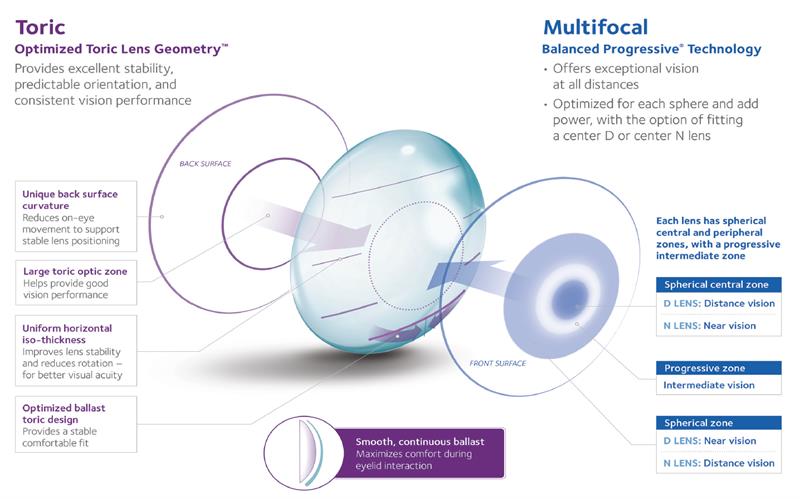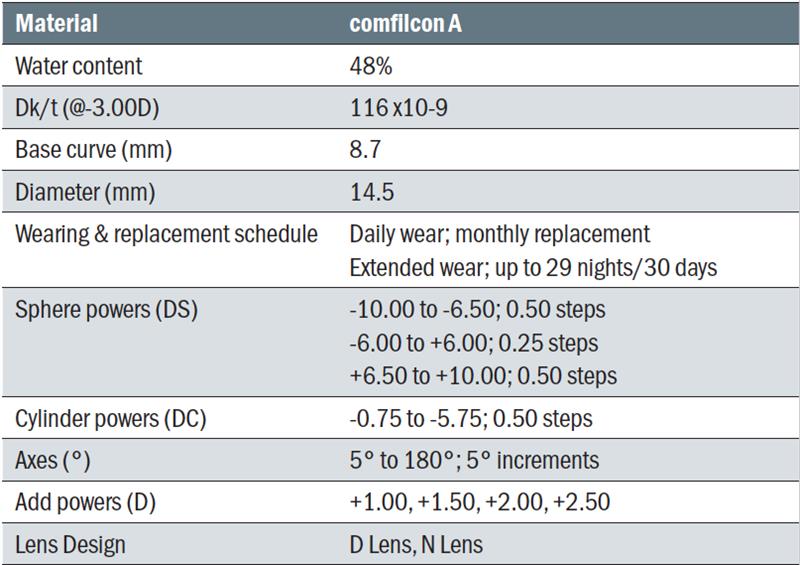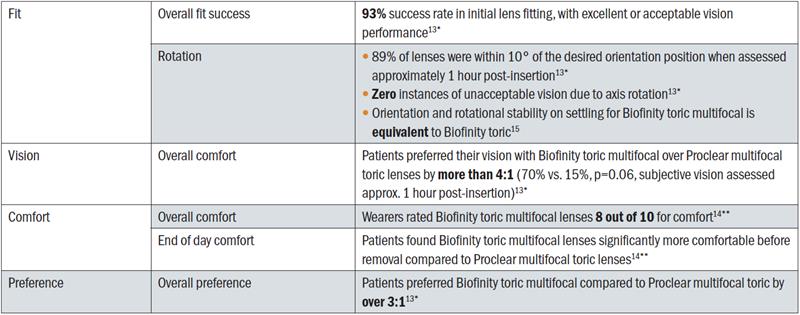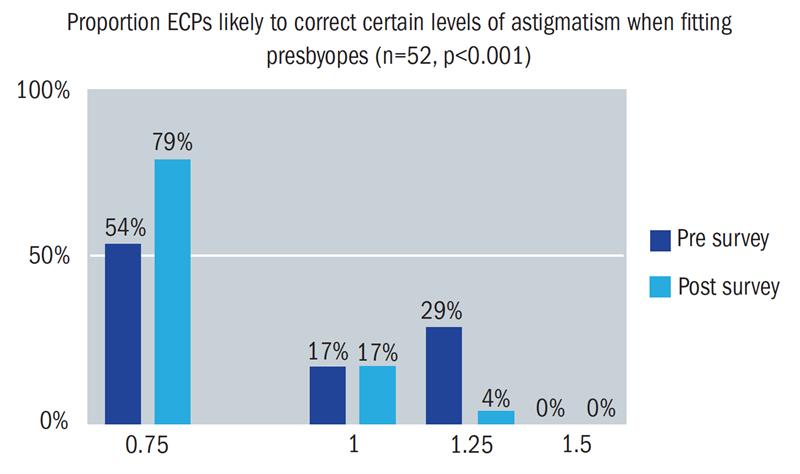
While there are now many options available to eye care professionals (ECPs) to correct spherical, astigmatic and presbyopic prescriptions with soft contact lenses for their patients, many contact lens (CL) wearers do not always have their prescription fully corrected, especially as it changes with the onset of presbyopia. Existing and emerging presbyopes will need forthcoming advice on how best to correct their vision with CLs, and if they, like around 40% of the vision corrected population, also have at least 0.75DC of astigmatism,1 then the need for a reliable toric multifocal lens becomes clear. In fact, it is estimated that one-third of toric CL wearers are of presbyopic age2 and ECPs may reasonably expect to be faced with increasing numbers of astigmatic presbyopes seeking correction options with CLs.
Biofinity sets a standard for sustained innovation
Since 2006, CooperVision has developed cutting edge technologies (figure 1) and strong performing products to help meet the different and evolving needs of patients worldwide; and with this the Biofinity family has become one of the most widely prescribed reusable lenses globally. This is in part thanks to its wide prescription range, with over 20 times more prescription options than any other family of contact lenses,3 providing correction for 99.7% of prescriptions.4
 Figure 1: Timeline of Biofinity Innovation
Figure 1: Timeline of Biofinity Innovation
Demand for toric multifocal correction
With an ageing global population, the opportunity to offer CLs as part of a vision correction choice is large and increasing. That opportunity exists both for current CL wearers as they become presbyopic, and for current and emerging presbyopes who may wish to consider CLs in addition to their spectacles, potentially regaining some lost convenience of having to otherwise rely on reading spectacles. Given that a third of patients aged 41 and over have 0.75DC or more of astigmatism in at least one eye,1 additional innovation in the area of toric multifocal CL options is desirable. Alternative methods of correction for this astigmatic presbyopic patient group all include compromise, such as adding reading spectacles to toric distance CLs, wearing monovision CLs, continuing in spectacles full time or, for low astigmats, best sphere only correction of their distance refraction.
Numerous factors contribute to successful CL wear, but comfort, vision and handling are most commonly focused on, with drop out reported in different patient groups when these performances are suboptimal.5-9 Dissatisfaction with visual performance is particularly related to drop out for both toric and multifocal CL wearers,6,8,9 demonstrating the importance of being able to recommend CLs that are designed to address both of these vision correction needs. Furthermore, age-related changes are known to degrade the tear film,10,11 making the CL material an additional important consideration for presbyopes as they seek the best possible comfortable wearing experience.
Silicone hydrogel adoption
The use of silicone hydrogel (SiHi) materials is now widely popular, particularly for reusable CLs; they represent around 80% of all reusable fits in the nine countries with 15 consecutive years of data in the international CL prescribing report.12 Prescribing SiHi materials with their high levels of oxygen transmissibility (Dk/t), provides ECPs with a safety net to minimise potential hypoxia-related complication for many wearers who use their lenses for long hours.13 Since the vast majority of soft lenses are worn during the day and removed at night, the amount of corneal swelling that occurs in open eye wear is most relevant clinically, and measurements of the lens, or cornea, should be made both centrally and peripherally. It has been reported that a Dk/t of at least 33 x 10-9 barrers/cm across the entire soft CL is required ‘for a typical wearer’, to avoid corneal oedema during open eye wear.14 This is particularly important for higher minus, plus, toric and toric multifocal soft lenses where the lens may be thicker and the oxygen demands higher. Having a toric multifocal design in a SiHi material is a welcome addition for ECPs to add to their toolbox of fitting options.
 Figure 2: Optimised Toric Lens Geometry and Balanced Progressive Technology
Figure 2: Optimised Toric Lens Geometry and Balanced Progressive Technology
Combining proven technologies
Biofinity toric multifocal comprises a unique combination of technologies, bringing together proven features already available in the Biofinity portfolio, into one lens designed to meet the needs of patients. The lenses are manufactured using the same SiHi material (comfilcon A) used in all Biofinity lenses, using the same high precision and repeatable manufacturing process as Biofinity XR toric lenses.
Optimised Toric Lens Geometry
Designed for a reliable fit, Optimised Toric Lens Geometry lenses incorporate a unique back surface curvature to minimise on-eye movement and rotation and support stable lens positioning (figure 2). Stability is also driven by the optimised toric design, and uniform horizontal iso-thickness. In addition to the features for stability, vision is further supported by a large toric optic zone. Biofinity toric design has been shown to have superior stability with the lowest lens rotation in primary gaze versus other widely used toric lens designs.15
Balanced Progressive Technology
Designed for exceptional vision, Balanced Progressive Technology is optimised for each sphere and add power, with two distinct optical designs providing the choice of centre distance (D) or centre near (N) lenses (figure 2); this means there are eight multifocal (MF) designs in total to help optimise visual acuity. The advanced design contains multiple zones of vision correction in both lenses, which enable fitting to be tailored to each patient, for clear near, intermediate and distance vision.
Aquaform Technology
Aquaform Technology, common to all Biofinity lenses, allows for naturally wettable SiHi materials without the need for surface treatment. In the matrix of long silicone chains, hydrogen bonds form to lock water molecules within the lens, for inherent wettability and a comfortable lens-wearing experience. This allows the lens to attract and retain moisture, which is increasingly important with an aging population that is prone to dryness symptoms.11 The long chains mean less silicone is needed, resulting in a material with balanced properties of water content (48%), modulus (0.75 MPa), and oxygen transmissibility (Dk/t 116 x 10-9 @ -3.00D). See table 1.
 Table 1: Biofinity toric multifocal specifications
Table 1: Biofinity toric multifocal specifications
Clinical performance
Study design
How does the unique combination of technologies in Biofinity toric multifocal work together? Clinical studies have been conducted to evaluate the performance of the lens. A non-dispensing, subject masked, randomised, bilateral, cross-over, short-term clinical evaluation at two sites in the UK and US, fit 27 astigmatic, presbyopic soft CL wearers with Biofinity toric multifocal and Proclear multifocal toric using their respective fitting guides.16 A second study fit the same two lenses to 23 subjects in a subject masked, randomised, bilateral, two-week cross-over dispensing study.17
Fit success
The results show high levels of success with Biofinity toric multifocal, in terms of lens fit, rotational stability, orientation position and subjective vision performance (table 2). Excellent or acceptable vision performance was achieved at initial lens fitting in more than nine out of 10 patients.16 Clearly, for a toric lens, that visual performance is dependent on predictable and consistent orientation of the lens and rotational stability. When assessed approximately one hour post-insertion nearly nine out of 10 lenses were within 10° of the desired position, and there were no instances of mis-rotation causing unacceptable vision.16 For ECPs familiar with the performance of Biofinity toric with Optimised Toric Lens Geometry, it is also reassuring to see that orientation and rotational stability on settling for Biofinity toric multifocal was equivalent to that with Biofinity toric.18
 Table 2: Results of non-dispensing short-term evaluation of Biofinity multifocal toric, *n=27, **n=23
Table 2: Results of non-dispensing short-term evaluation of Biofinity multifocal toric, *n=27, **n=23
Subjective response
Patient feedback was gathered on vision and comfort with Biofinity toric multifocal and Proclear multifocal toric, along with their preference between the two study lenses. The results are summarised in table 2. The ability to deliver good visual performance is key to success with all wearers, and in particular for this astigmatic presbyopic patient group. When subjective vision was assessed approximately one hour post-insertion, patients rated the distance performance of Biofinity toric multifocal significantly higher than Proclear multifocal toric (87 vs 77; p=0.01), with similar performance reported between the two lens types for intermediate and near vision.16 Patient preference was strongly in favour of the new lens, with Biofinity toric multifocal preferred 4:1 over Proclear multifocal toric for overall vision.16
High levels of comfort were found with Biofinity toric multifocal (table 2), with the lenses being more comfortable during the day and less dryness at the end of the day than Proclear multifocal torics.17 When questioned about their overall preference one-hour post-insertion, patients chose Biofinity toric multifocal over Proclear multifocal toric by a ratio of more than 3:1.16
Real world performance
While clinical studies provide objective performance in a controlled environment, ECP and wearer experience in a practice environment is also an important measure of success with any product. In order to assess the performance of Biofinity toric multifocal in a real-world situation, a large scale, multi-centre observational survey was conducted from March to October 2020.19 A total of 54 ECPs from France, UK, USA, Spain, Portugal, Nordics, Germany, Austria, Switzerland, Belgium and Netherlands completed pre- and post-fitting assessment questionnaires. Patient satisfaction data were collected via 409 pre- and post-fit logs gathered from existing and new contact lens wearers with mean age 53 years and prescriptions ranging from +10.00 to -10.25DS and -0.75 to -5.75DC.
ECP results
After trialling Biofinity toric multifocal, the proportion of ECPs who said they would fit toric multifocal contact lenses to patients with 0.75D cylinder increased from 54% to 79% (p<0.001, figure 3). This suggests confidence in the product performance to meet the needs of astigmatic presbyopes and a change in perception as a result of its use. Ninety-six percent agreed that the lens was an excellent option for astigmatic presbyopes interested in contact lenses and 87% agreed that they provided a predictable, stable fit. Ninety-six percent of Biofinity toric multifocal trials resulted in acceptable fit at follow-up and 85% were dispensed without any modification needed.
Patient satisfaction
Average patient rating at follow-up was high; 8.2/10 for overall satisfaction, 8.3/10 for overall vision and 8.7/10 for overall comfort. Ninety percent of patients who wore Biofinity toric multifocal would recommend them to family and friends, 74% preferred them to their habitual lenses and 73% who took part in the survey said they intended to purchase the lenses.
These results highlight the overall success and wearer satisfaction for vision, comfort and overall, with both habitual wearers and neophytes in Biofinity toric multifocal.
Tips for success
Patient selection
An obvious use of this lens is to recommend it to existing toric CL wearers as they become presbyopic. It would typically be expected for it to be easier to transition from single vision to multifocal CL correction with a low reading addition. Recommending Biofinity toric multifocal would be a natural progression for these emerging presbyopes. Astigmats corrected with spectacles need to adapt to greater compromise with their vision as presbyopia manifests. Whether that be via varifocal correction, or additional reading spectacles, they will experience a change in how they view the world. These patients may benefit from exploring the option of CLs for the first time to provide an alternative option to the compromise of reading spectacles or varifocals. Finally, because Biofinity toric multifocal is part of the Biofinity family, the lens delivers the opportunity for flexible prescribing. A presbyope with monocular astigmatism may be corrected with Biofinity toric multifocal in one eye and Biofinity multifocal in the other.
 Figure 3: After trialling Biofinity toric multifocal, the proportion of ECPs likely to correct lower levels of astigmatism (-0.75DC) when fitting presbyopes during a large, multi-centre, observational survey19
Figure 3: After trialling Biofinity toric multifocal, the proportion of ECPs likely to correct lower levels of astigmatism (-0.75DC) when fitting presbyopes during a large, multi-centre, observational survey19
Prescription range
Biofinity toric multifocal is available, in a wide range of sphere, cylinder, and add powers, with axes in 5° steps. This range delivers over 200,000 unique prescription options,20 with the provision of correction for 99.6% of astigmatic presbyopes,21 truly enabling a custom-made solution for patients (table 1).
Fitting support
Achieving reliable, accurate and quick fits in practice is crucial to the success of any contact lens. Accurate trial lens selection is important for successful soft toric fitting, and multifocal lens success is enhanced by using the manufacturers’ recommended fitting guides. The OptiExpert tool, available online and as an app, manages both of these considerations for ECPs. ECPs can already benefit from using the tool to help save chair time, with the confidence that for Biofinity multifocal, 98% of wearers can be successfully fit using two pairs of lenses or less.22 The new OptiExpert tool now combines the toric and multifocal calculators to help select the initial Biofinity toric multifocal lens. In addition, the OptiExpert tool also includes spherical lenses to make lens selection for all CooperVision lenses easy.
Lens care product combinations with comfilcon A
Selection of an appropriate lens care product to prescribe with a frequent replacement SiHi lens such as Biofinity is important to help with overall clinical performance and wearer acceptance. Two recent studies have demonstrated that comfilcon A material (spherical lens) performed well when worn with three widely used lens care products (Refine One Step, Hy-Care and All In One Light) for cleaning, deposition, biomicroscopy and subjective scores, and the combinations were well accepted and performed well clinically for both short term performance and over one month of daily wear.23,24
Conclusion
The ECP experience combined with patient subjective and preference responses demonstrate the high level of clinical performance Biofinity toric multifocal can deliver. This is important for ECPs, giving confidence that the lens can be fit accurately and successfully and that it performs well for patients in terms of vision and comfort.
The Biofinity family of CLs with Aquaform technology has continually produced new, patient-led innovation through high precision, repeatable manufacturing processes since its launch. Biofinity toric multifocal is the newest addition to the family, uniquely combining the high performing designs of Biofinity toric and Biofinity multifocal into one lens design and delivering on patients’ needs in terms of vision and comfort. With its extensive range of prescriptions, Biofinity toric multifocal has been designed to meet a growing need for patients as their vision changes. And with the smarter than ever OptiExpert App tool, first trial selection of Biofinity toric multifocal is also made easier. Whether the need is for near, intermediate, or distance vision, Biofinity toric multifocal lenses provide effective vision correction for a wide range of astigmatic presbyopic patients.
- Marcella McParland is Professional Services Senior Director EMEA, Dave Webley is Professional Services Senior Manager EMEA and Anna Sulley is Global Medical Affairs Director at CooperVision.
Acknowledgement
This article is based on one first published in the journal Optyka, Poland in August 2020. McParland M et al. Innowacja w świecie soczewek kontaktowych spełniająca oczekiwania pacjentów z astygmatyzmem i prezbiopią, Optyka, 2020;4:53-57.
References
- Luensmann D, Schaeffer JL, Rumney NJ, et al. Spectacle prescriptions review to determine prevalence of ametropia and coverage of frequent replacement soft toric contact lenses. Contact Lens and Anterior Eye 2018;41:412-20.
- Industry fit data, January 2017- December 2017. Italy, UK and Germany. 41% of toric CL wearers age 41 years or over.
- CVI data on File 2020. Based on prescription options available across all soft lenses in sphere, toric, multifocal and toric multifocal, SiHi and hydrogel, stock and made-to-order from 4 main manufacturers in UK, Germany, Italy and France. Cosmetic & Photochromatic CLs not included. Multiple base curve variants not included.
- CVI data on file 2020. Rx coverage database; 14-70 years. Across sphere, toric and multifocal prescriptions.
- Sulley A, Young G, Hunt C. Factors in the success of new contact lens wearers. Contact Lens and Anterior Eye 2017;40:15-24.
- Sulley A, Young G, Hunt C, et al. Retention Rates in New Contact Lens Wearers. Eye and Contact Lens 2018;44 Suppl 1:S273-S82.
- Dumbleton K, Woods CA, Jones LW, et al. The impact of contemporary contact lenses on contact lens discontinuation. Eye and Contact Lens 2013;39:93-9.
- Young G. Why one million contact lens wearers dropped out. Contact Lens and Anterior Eye 2004;27:83-5.
- Young G, Veys J, Pritchard N, et al. A multi-centre study of lapsed contact lens wearers. Ophthalmic and Physiological Optics, 2002;22:516-27.
- Patel S, Boyd KE, Burns J. Age, stability of the precorneal tear film and the refractive index of tears. Contact Lens and Anterior Eye 2000;23:44-7.
- du Toit R, Situ P, Simpson T, et al. The effects of six months of contact lens wear on the tear film, ocular surfaces, and symptoms of presbyopes. Optometry and Vision Science 2001;78:455-62.
- Morgan P, Woods C, Tranoudis IG, et al. International Contact Lens Prescribing in 2019. Contact Lens Spectrum 2020;35:26-32.
- Efron N. Twenty years of silicone hydrogel contact lenses: a personal perspective. Clinical and Experimental Optometry. DOI:10.1111/cxo.13062. 2020.
- Morgan PB, Brennan NA, Maldonado-Codina C, Quhill W, Rashid K, Efron N. Central and peripheral oxygen transmissibility thresholds to avoid corneal swelling during open eye soft contact lens wear. Journal of Biomedical Materials Research Part B: Applied Biomaterials. 2010;92:361-5.
- Momeni-Moghaddam H, Naroo SA, Askarizadeh F, et al. Comparison of fitting stability of the different soft toric contact lenses. Contact Lens and Anterior Eye 2014;37:346-50.
- CVI data on file 2018. Non-dispensing, subject masked, randomized, bilateral, cross-over short-term evaluation. 27 subjects at 2 sites (UK and US) fitted using CVI fit guide.
- CVI Data on file 2017. Dispensing study. Subject masked, randomized, bilateral, crossover 2-week dispensing study controlled by cross-comparison. 23 astigmatic, presbyopic soft CL wearers fitted using CVI fit guide.
- CVI data on file 2019. Sub-analysis of lens stability on settling with Biofinity toric & Biofinity toric multifocal. N=89.
- CVI data 2020. Observational in-practice assessment with Biofinity toric multifocal in France, Nordics, Benelux, Iberia, DACH, UK, US with 54 ECPs and 409 wearers.
- CVI data on file 2019. Based on total number of prescription option combinations manufactured (for sphere, cylinder, axis, and add—including D & N combinations).
- CooperVision data on file 2020. Rx coverage database; 42 to 70 years ≥0.75DC
- CVI data on file 2019. Retrospective analysis; N=55 subjects (110 eyes); DV Rx +1.25D to -3.25D, ADD powers +1.25 to +2.50DS
- Mirza, A, Smith, A, George, M and Morgan, P. A clinical investigation of the short-term clinical performance to a range of contact lens and care system combinations. Contact Lens and Anterior Eye, (2019); 42(6): supplement 1.
- CooperVision data on file 2020. Randomised, open label, crossover clinical study; FRP lens and solution combinations for 1-month daily wear; n=33 existing soft CL wearers.
